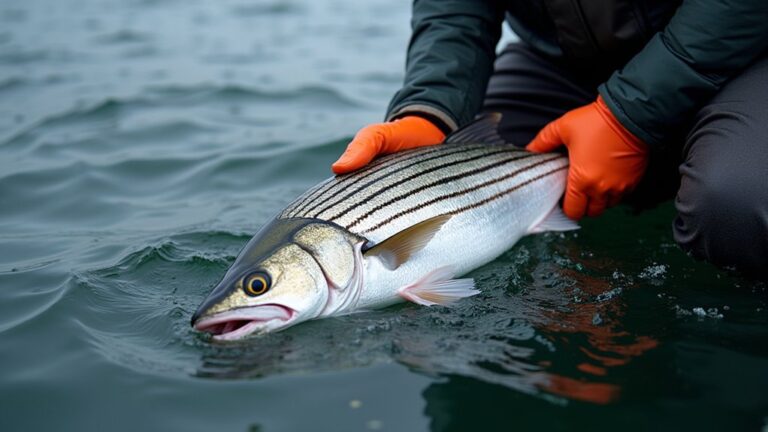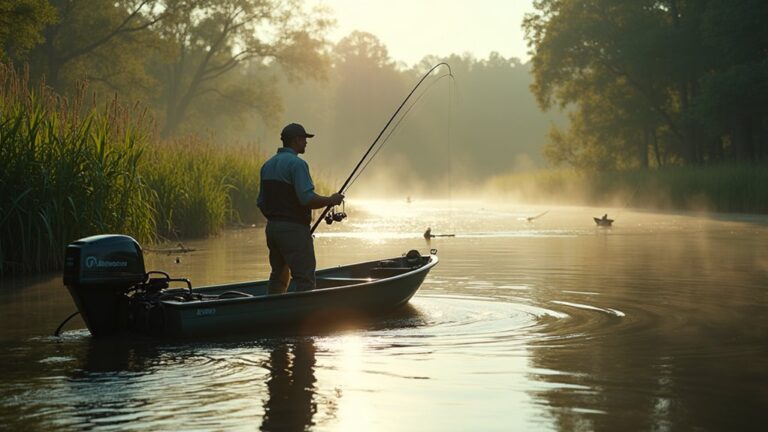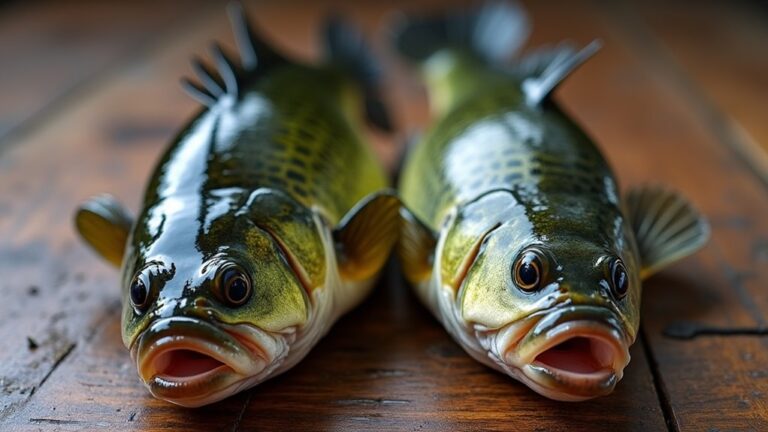To master freshwater fish identification, start by understanding basic fish anatomy and learning common fish families. Study distinctive body shapes and analyze fin structures, as these are key identifiers. Observe coloration and markings, but remember they can vary with environment and season. Examine mouth and teeth structures to understand feeding habits. Consider habitat and behavior, as they provide valuable clues. Practice with field guides to familiarize yourself with local species. Join fishing clubs and engage with experts to enhance your knowledge. The more you immerse yourself in this fascinating world, the more proficient you'll become in identifying freshwater fish.
Understand Basic Fish Anatomy
To plunge into freshwater fish identification, you'll need to grasp the basics of fish anatomy. Start by familiarizing yourself with the key structures: gills for breathing, scales for protection, and fins for movement.
Pay close attention to the mouth structure, as it reveals important information about feeding habits. You'll encounter superior, inferior, and terminal mouth shapes, each indicating different ecological roles.
Understanding fins is fundamental. Learn to distinguish between dorsal, pectoral, pelvic, anal, and caudal fins. Each type serves specific functions in movement, stability, and maneuverability.
As you observe fish, note their body shapes and sizes, which are crucial for accurate identification.
Color patterns and markings are also significant clues. Look for stripes, spots, or solid colors that can help you identify fish species and understand their camouflage strategies.
Learn Common Fish Families
Familiarity with common fish families is the cornerstone of successful freshwater fish identification. To identify a fish accurately, you'll need to recognize the key characteristics of major fish families. In the Great Lakes region alone, there are 28 major fish families, each with unique traits that set them apart.
Start by learning to identify common fish families like Centrarchidae (sunfish) and Percidae (perch). These families have distinct body shapes and fin structures that'll help you differentiate between species.
The Salmonidae family, which includes trout and salmon, is known for streamlined bodies and distinctive coloration, often featuring spots or marbling.
Don't forget about the Ictaluridae family, which includes catfish. You'll recognize them by their whisker-like barbels and broad, flattened heads.
The Esocidae family, including pike and muskellunge, is characterized by elongated bodies, sharp teeth, and forked tails.
As you practice identifying fish species, you'll begin to recognize these family traits more easily. Remember, each family has its own set of unique characteristics that'll help you narrow down your identification quickly and accurately.
Study Distinctive Body Shapes

Various distinctive body shapes characterize freshwater fish species, providing valuable clues for identification. Understanding these shapes is essential for accurate fish identification. For example, the anguilliform shape, common in eel-like species, allows for exceptional maneuverability in tight spaces. In contrast, the compressiform shape, typical of flounders, aids in camouflage against the substrate.
To improve your fish identification skills, focus on these key aspects:
- Learn to recognize common body shapes associated with specific families
- Observe how body shape influences swimming behavior and efficiency
- Use body shape as an initial clue to narrow down potential species
Body shape isn't just about aesthetics; it's a product of evolutionary adaptations to different ecological niches. Streamlined bodies reduce drag for faster swimming, while broader bodies enhance stability in turbulent waters. By studying these distinctive shapes, you'll be better equipped to identify different species in freshwater environments.
Remember that body shape is just one piece of the puzzle. Combine your knowledge of shapes with other characteristics like coloration and fin structure to confidently identify common species and distinguish between closely related fish.
Analyze Fin Structures
Analyzing fin structures is an essential skill for mastering freshwater fish identification. You'll need to focus on the dorsal, pectoral, pelvic, anal, and caudal fins, as they provide distinct characteristics that help differentiate species.
Pay close attention to the shape and size of dorsal fins, which can vary greatly. Some species, like black bass, have spiny dorsal fins, while others feature soft-rayed dorsal fins.
To identify closely related species, count the number of soft rays and spines in fins, a technique known as meristics. This method is particularly useful when distinguishing between different types of sunfish.
Examine tail fin shapes, which can be rounded, forked, or square. These shapes not only contribute to a fish's swimming abilities but also serve as identifying features. For example, fast swimmers like pike often have forked tails.
Don't overlook pectoral fin lengths and positions, as they can vary among species. Catfish, for instance, have long, broad pectoral fins that aid in maneuverability and serve as an identifying factor.
Observe Coloration and Markings

With a keen eye for color and patterns, you'll reveal another crucial aspect of freshwater fish identification. Coloration and markings vary widely among freshwater species, often serving as key identification features.
You'll need to take into account that these characteristics can change based on the fish's environment, age, and breeding season. Many species exhibit sexual dimorphism, where males and females display different colors and patterns, especially during breeding seasons.
Additionally, understanding how factors like best times for bass fishing can influence visibility may aid in your identification efforts. To effectively observe coloration and markings for species identification:
- Look for distinctive features like the bluegill's dark spots near its dorsal fin.
- Note vibrant colors, such as those of male rainbow trout during spawning.
- Pay attention to patterns like stripes, spots, or solid colors.
Remember that coloration alone isn't always enough to identify a species accurately. You'll need to combine this information with other characteristics, such as fin structures and body shape.
Examine Mouth and Teeth
Explore the world of fish mouths and teeth to reveal crucial identification clues. Freshwater fish mouth shapes fall into four main categories: superior (upturned), inferior (downturned), terminal (at the end), and elongated. Each shape indicates specific feeding behaviors and ecological roles, helping you narrow down species possibilities.
Pay close attention to the presence and arrangement of teeth, including pharyngeal teeth in some species like suckers. These features provide insights into dietary habits and preferences, further aiding in identification.
You'll notice that mouth orientation distinguishes surface feeders, such as mosquitofish with superior mouths, from bottom feeders like Sacramento suckers with inferior mouths.
As you examine teeth, remember that size and visibility vary greatly among species. Predatory fish like pike have prominent teeth for catching prey, while others may have reduced or no visible teeth.
To enhance your identification accuracy, consider mouth features alongside habitat preferences. Certain mouth forms are adapted to specific feeding strategies within their environments.
Consider Habitat and Behavior

Understanding a fish's habitat and behavior is vital for accurate identification. When you're trying to identify freshwater species, consider the following factors:
- Water temperature preferences
- Feeding habits and locations
- Seasonal behavioral patterns
Different fish species thrive in specific water temperatures. Warm water fish prefer temperatures around 80°F, while cool water species inhabit areas between 60°F and 80°F. Cold water fish, like trout, are found in waters below 60°F.
Observing a fish's behavior can provide valuable clues for identification. Bottom-feeding species, such as catfish, exhibit different habits compared to surface feeders like mosquitofish.
Pay attention to seasonal behaviors, as many fish species undergo spawning migrations that affect their location and visibility throughout the year. Knowing preferred habitats is fundamental; trout are often found in cold, clear streams, while bass may inhabit warmer, shallow waters.
Fish coloration and patterns can vary based on their environment, aiding in camouflage. Species in murky waters may have darker hues compared to those in clear waters.
Practice With Field Guides
Field guides are essential tools for mastering freshwater fish identification. These invaluable resources provide detailed descriptions, illustrations, and range maps for over 160 species found in the Great Lakes region.
When selecting a guide, look for one that includes distinguishing features such as body shape, coloration, and fin structure, which are vital for accurate identification in various habitats.
To effectively use your field guide, focus on learning to differentiate fish based on their unique characteristics. Pay attention to life stages and variations within species, as these can greatly impact appearance.
As you practice, you'll become more adept at recognizing subtle differences between similar-looking fish.
Carry a portable field guide with you while fishing, allowing for quick comparisons between your catches and the visual aids provided. This hands-on approach will help you rapidly improve your identification skills.
Don't hesitate to engage with local fish and wildlife experts or join fishing clubs to gain additional insights. These resources can recommend the best field guides tailored to your specific region and species of interest, further enhancing your ability to identify fish accurately in the field.
Conclusion
You've now got the tools to become a fish identification whiz. Remember, practice makes perfect, so get out there and start observing. As you hone your skills, you'll find identifying fish becomes as natural as breathing underwater. Keep your field guide handy, and don't be afraid to ask fellow anglers or experts for help. With time and patience, you'll be reeling in your identifications like a pro.




